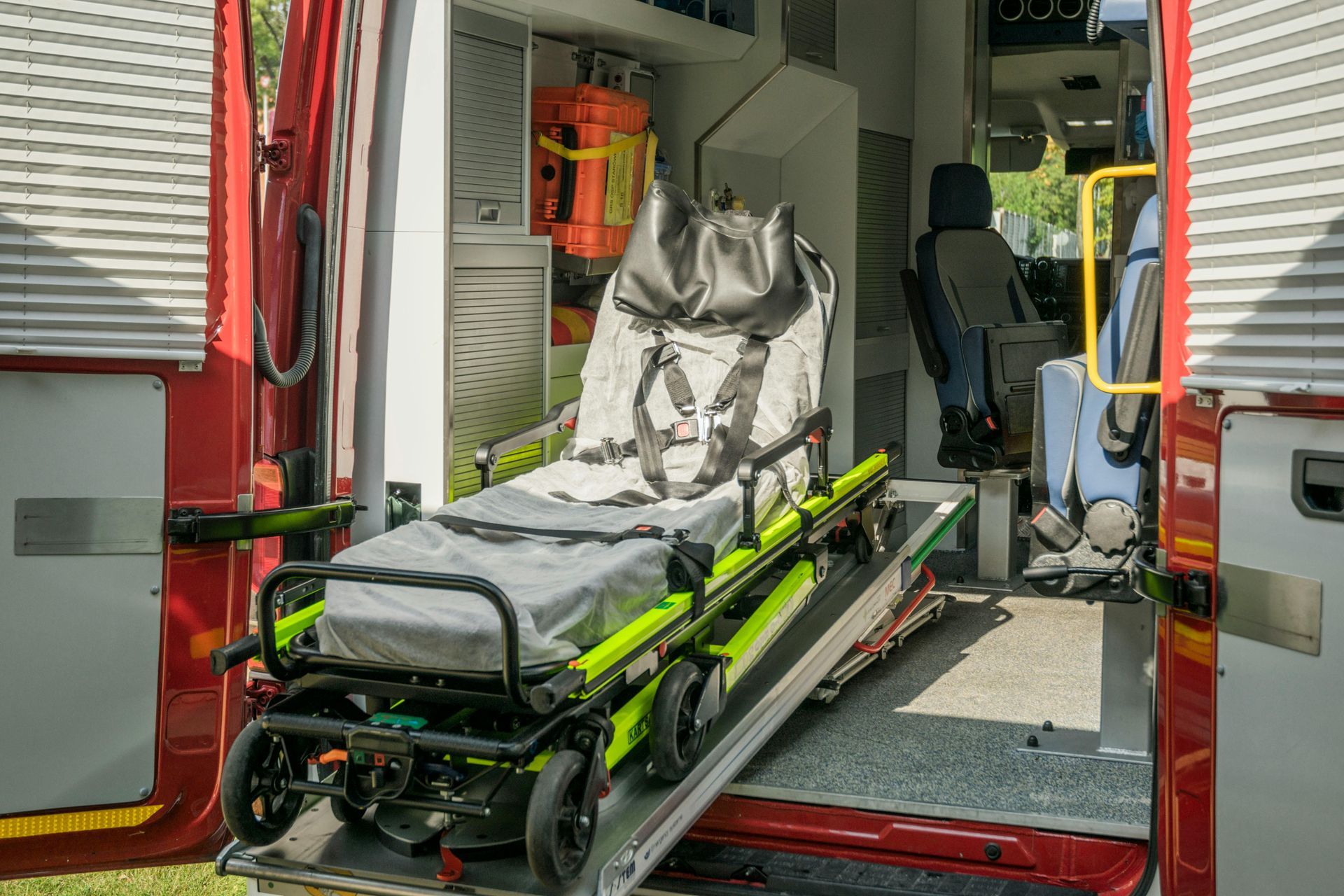What it Takes: Non-Emergency Medical Transportation Training?
What’s Involved in Non-Emergency Medical Transportation Training?
Non-Emergency Medical Transportation (NEMT) is a vital service that ensures individuals with mobility challenges can access essential healthcare resources. However, behind the scenes, there's a crucial element that often goes unnoticed: the training of NEMT professionals. These individuals play a pivotal role in providing safe, reliable, and compassionate transportation for patients, making their training an integral part of the NEMT process. So, what exactly does it take to become an NEMT professional? Let's delve into the details to understand the training involved in non-emergency medical transportation.

Training for Non-Emergency Medical Transportation:
What's Involved
Non-emergency medical transportation (NEMT) plays a crucial role in providing transportation services to individuals who require assistance in reaching medical appointments, clinics, and healthcare facilities. To ensure the safe and efficient operation of NEMT services, specialized training is essential for both drivers and operators. In this article, we will explore the key components of non-emergency medical transportation training, highlighting the unique hands-on extensions that make it a comprehensive and valuable experience.
Understanding Non-Emergency Medical Transportation
Before delving into the training aspects, it is vital to comprehend the significance of non-emergency medical transportation in the healthcare landscape. NEMT refers to the transportation of patients who do not require immediate medical attention but still need assistance due to physical limitations, medical conditions, or other disabilities. By facilitating reliable transportation, NEMT services contribute to enhancing access to healthcare, reducing missed appointments, and improving overall patient outcomes.
In non-emergency medical transportation, drivers must be equipped to handle the unique challenges that come with transporting individuals with varying medical conditions. They need to understand the importance of providing a safe and comfortable environment for passengers. This includes being aware of the physical limitations that passengers may have and ensuring their needs are met during transportation.
The Importance of Training for NEMT
Operating a non-emergency medical transportation service involves more than simply driving patients from one location to another. It requires specialized knowledge, skills, and understanding of the unique needs and challenges associated with transporting individuals with varying medical conditions. Adequate training is crucial to ensure the safety, comfort, and well-being of the passengers, as well as the overall success of the NEMT service provider.
Proper training for NEMT drivers is essential for several reasons. First and foremost, it ensures the safety of both the driver and the passengers. NEMT drivers must be trained in defensive driving techniques, understanding traffic laws and regulations, and managing various road situations. This includes mastering vehicle handling, emergency procedures, and accident prevention strategies. By equipping drivers with this knowledge, the risk of accidents and injuries during transportation can be significantly reduced.
Additionally, training in passenger assistance and care is essential for NEMT drivers. They often need to provide assistance to passengers with mobility challenges or special medical needs. This includes proper lifting and transferring techniques, wheelchair handling, and familiarization with medical equipment or devices that passengers may require during transportation. By receiving training in these areas, drivers can ensure that passengers are safely and comfortably transported to their destinations.
Core Components of NEMT Training
- Driver Safety: One of the primary focuses of NEMT training is driver safety. Drivers must be trained in defensive driving techniques, understanding traffic laws and regulations, and managing various road situations. This includes mastering vehicle handling, emergency procedures, and accident prevention strategies. Drivers also have to be trained on using equipment that is operated on patients to ensure no risk or injury occurs while handling critical patients in their residences.
- Defensive driving techniques: NEMT drivers should be trained to anticipate potential hazards on the road and take proactive measures to avoid accidents. This includes maintaining a safe following distance, being aware of blind spots, and staying alert at all times.
- Understanding traffic laws and regulations: NEMT drivers should have a thorough understanding of traffic laws and regulations to ensure compliance and prevent traffic violations.
- Managing various road situations: NEMT drivers should be trained to handle different road situations, such as construction zones, heavy traffic, and adverse weather conditions. This includes knowing when to adjust driving speed and being prepared for unexpected circumstances.
- Passenger Assistance and Care: NEMT drivers often need to provide assistance and care to passengers with mobility challenges or special medical needs. Training should cover proper lifting and transferring techniques, wheelchair handling, and familiarization with medical equipment or devices that passengers may require during transportation.
- Proper lifting and transferring techniques: NEMT drivers should be trained in safe lifting and transferring techniques to ensure the physical well-being of passengers with mobility challenges. This includes understanding correct body mechanics, using assistive devices when necessary, and avoiding injuries to both the driver and the passenger.
- Wheelchair handling: NEMT drivers should receive training on how to properly secure and handle wheelchairs to prevent accidents and ensure the safety of passengers during transportation.
- Familiarization with medical equipment: NEMT drivers should be familiar with common medical equipment or devices that passengers may require during transportation. This includes understanding how to properly use and maintain equipment such as oxygen tanks or medical monitoring devices.
- Medical Knowledge: NEMT drivers should have a basic understanding of various medical conditions, disabilities, and special needs. Training in recognizing medical emergencies, administering basic first aid, and effectively communicating with healthcare professionals can greatly enhance the quality of service provided to passengers.
- Recognizing medical emergencies: NEMT drivers should receive training on how to recognize signs of medical emergencies and respond appropriately. This includes understanding symptoms of common medical conditions, such as heart attacks or strokes, and knowing when to seek immediate medical attention.
- Administering basic first aid: NEMT drivers should be trained in basic first aid techniques to provide initial care in case of minor injuries or medical emergencies. This includes knowing how to perform CPR, control bleeding, and stabilize injuries until professional medical help arrives.
- Effective communication with healthcare professionals: NEMT drivers should be able to effectively communicate with healthcare professionals to provide necessary information about the passenger's condition or any changes in their medical status. This ensures continuity of care and promotes better patient outcomes.
- Communication and Customer Service: Effective communication skills are paramount for NEMT drivers. Training should emphasize active listening, empathy, and clear communication with passengers, their families, and healthcare providers. Additionally, customer service training helps drivers deliver a positive and compassionate experience to passengers.
- Active listening: NEMT drivers should be trained to actively listen to passengers, ensuring that their concerns and needs are understood and addressed. This includes maintaining eye contact, asking clarifying questions, and providing appropriate responses.
- Empathy: NEMT drivers should be empathetic towards passengers, recognizing their unique challenges and providing emotional support when needed. This helps create a caring and compassionate environment during transportation.
- Clear communication: NEMT drivers should communicate clearly and effectively with passengers, their families, and healthcare providers. This includes using simple and concise language, providing instructions or information in a way that is easily understood, and using appropriate non-verbal cues to convey messages.
- Navigational Skills: NEMT drivers should be proficient in using navigation tools and technologies to ensure efficient and timely transportation. Training should cover the use of GPS systems, mapping applications, and familiarization with local geographic areas, hospitals, clinics, and healthcare facilities.
- GPS systems and mapping applications: NEMT drivers should receive training on how to effectively use GPS systems and mapping applications to plan routes, navigate through unfamiliar areas, and estimate travel times accurately.
- Familiarization with local geographic areas: NEMT drivers should be familiar with the local geographic areas they serve, including the locations of hospitals, clinics, and healthcare facilities. This allows them to efficiently transport passengers and avoid unnecessary delays.
- Knowledge of alternative routes: NEMT drivers should be trained to identify alternative routes in case of unexpected road closures, heavy traffic, or other obstacles. This ensures timely transportation even in challenging situations.
Uniquehands-On Extensions
To elevate the comprehensiveness and effectiveness of NEMT training, Uniquehands-on extensions can be incorporated into the curriculum. These extensions provide practical experiences and simulations that mirror real-life scenarios, allowing trainees to apply their knowledge and skills in a controlled environment.
- Simulated Medical Emergency Scenarios: Trainees can participate in simulated medical emergency scenarios to enhance their ability to respond effectively and calmly in critical situations. This extension focuses on first aid techniques, CPR, and preparing drivers to handle unexpected medical events while transporting patients.
- First aid techniques: Trainees can practice first aid techniques such as controlling bleeding, bandaging wounds, and performing CPR. This prepares them to provide immediate care in case of medical emergencies during transportation.
- CPR training: Trainees can receive hands-on CPR training to learn the proper techniques and gain confidence in administering CPR when necessary. This can make a significant difference in saving lives during critical situations.
- Handling unexpected medical events: Simulated scenarios can help trainees develop the skills to handle unexpected medical events, such as seizures or allergic reactions, while ensuring the safety and well-being of passengers.
- Role-Playing Exercises: Role-playing exercises enable trainees to practice communication, customer service, and conflict resolution skills. By portraying various passenger personas and situations, trainees can develop the ability to adapt and provide appropriate support to individuals with diverse needs and personalities.
- Communication skills: Role-playing exercises can focus on improving communication skills by simulating different passenger interactions. Trainees can practice active listening, empathy, and clear communication to effectively address passenger concerns and provide necessary information.
- Customer service skills: Role-playing exercises can help trainees develop customer service skills by simulating various scenarios, such as dealing with upset or anxious passengers. This enhances their ability to provide a positive and compassionate experience to passengers during transportation.
- Conflict resolution skills: Trainees can practice conflict resolution skills by role-playing situations where passengers may have different needs or preferences. This helps them develop strategies to handle conflicts calmly and efficiently, ensuring a smooth and pleasant transportation experience.
- Practical Vehicle Maintenance Training: NEMT drivers should have a basic understanding of vehicle maintenance to ensure the reliability and safety of their transport vehicles. Hands-on training sessions can cover topics such as tire changing, fluid checks, and general vehicle inspections to address minor issues promptly and prevent breakdowns during transportation.
- Tire changing: Hands-on training sessions can teach NEMT drivers how to change a flat tire and properly inflate tires to ensure optimal performance and safety on the road.
- Fluid checks: NEMT drivers should receive training on how to check fluid levels, such as oil, coolant, and windshield washer fluid. This helps prevent mechanical issues and ensures the vehicle operates smoothly during transportation.
- General vehicle inspections: Hands-on training can include general vehicle inspections, where drivers learn to identify potential issues such as worn-out brake pads, malfunctioning lights, or damaged mirrors. This allows them to address minor maintenance needs promptly and prevent breakdowns or accidents during transportation.
Conclusion
Non-emergency medical transportation training encompasses a range of essential knowledge and skills that enable drivers to provide safe, reliable, and compassionate transportation to individuals with medical needs. By focusing on driver safety, passenger assistance and care, medical knowledge, communication, and navigational skills, NEMT training ensures the provision of high-quality services. The inclusion of unique hands-on extensions further enhances the training experience, preparing drivers to handle real-life situations and challenges effectively. Through comprehensive training, NEMT service providers can contribute significantly to improving healthcare access and patient outcomes.
FAQ
Q: What is non-emergency medical transportation (NEMT)?
A: Non-emergency medical transportation refers to the transportation of patients who do not require immediate medical attention but still need assistance due to physical limitations, medical conditions, or other disabilities. It plays a crucial role in enhancing access to healthcare and improving overall patient outcomes.
Q: Why is training important for NEMT drivers?
A: Training is essential for NEMT drivers to ensure the safety, comfort, and well-being of passengers, as well as the overall success of the NEMT service provider. It enables drivers to handle the unique challenges associated with transporting individuals with varying medical conditions and equips them with the necessary knowledge and skills to provide proper passenger assistance and care.
Q: What are the core components of NEMT training?
A: The core components of NEMT training include driver safety, passenger assistance and care, medical knowledge, communication and customer service, and navigational skills. These components cover areas such as defensive driving techniques, proper lifting and transferring techniques, recognizing medical emergencies, effective communication with healthcare professionals, and proficiency in using navigation tools.
Q: What are some unique hands-on extensions in NEMT training?
A: Some unique hands-on extensions in NEMT training include simulated medical emergency scenarios, role-playing exercises, and practical vehicle maintenance training. These extensions provide trainees with practical experiences and simulations that mirror real-life situations, allowing them to apply their knowledge and skills in a controlled environment. This enhances their ability to respond effectively in critical situations, adapt to diverse passenger needs, and ensure the reliability and safety of their transport vehicles.






